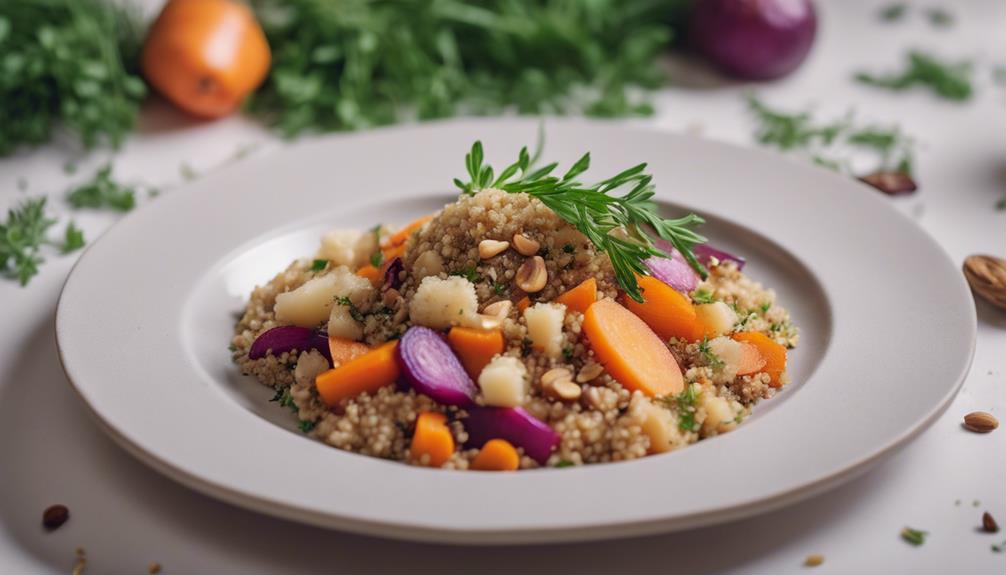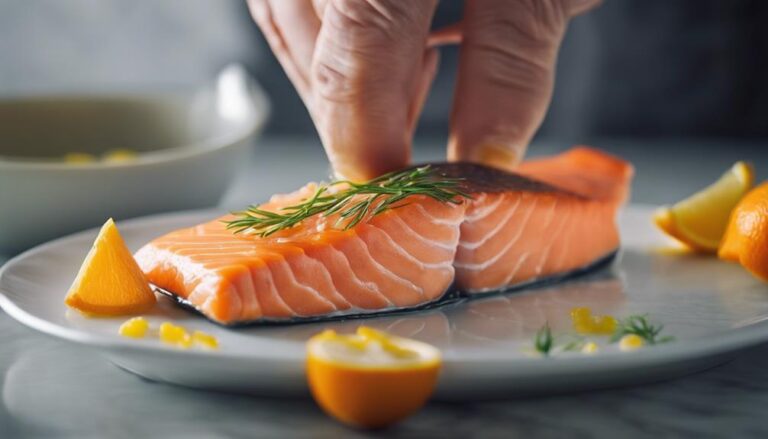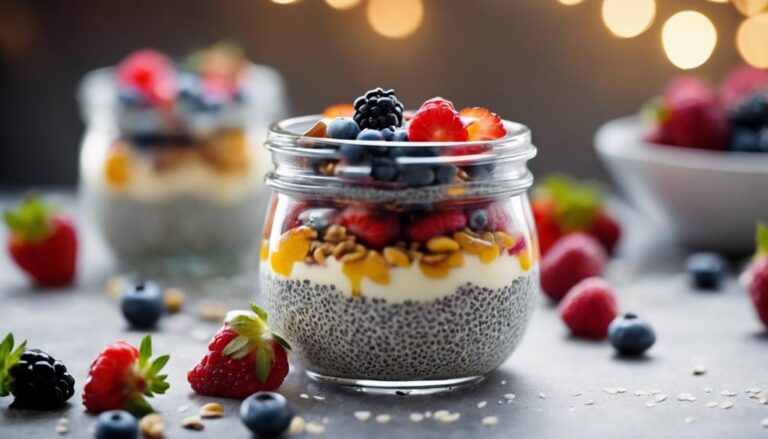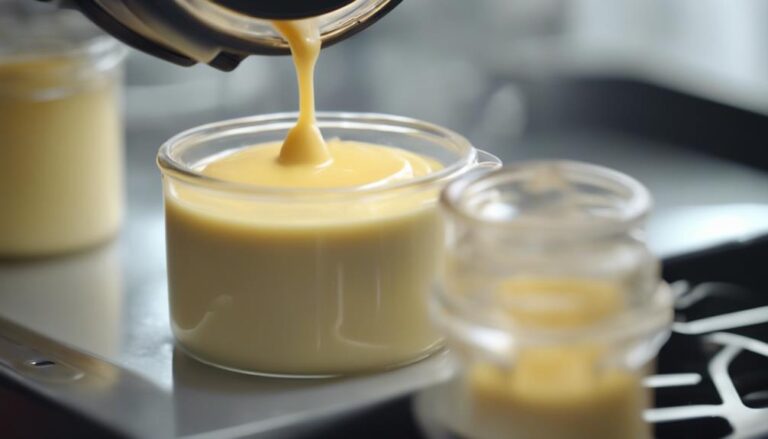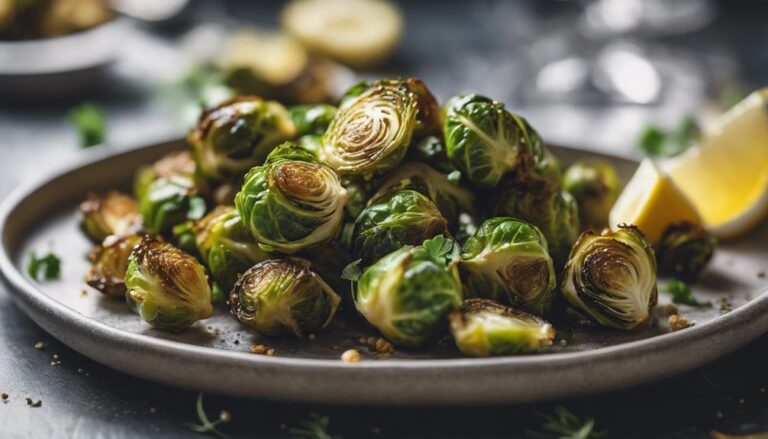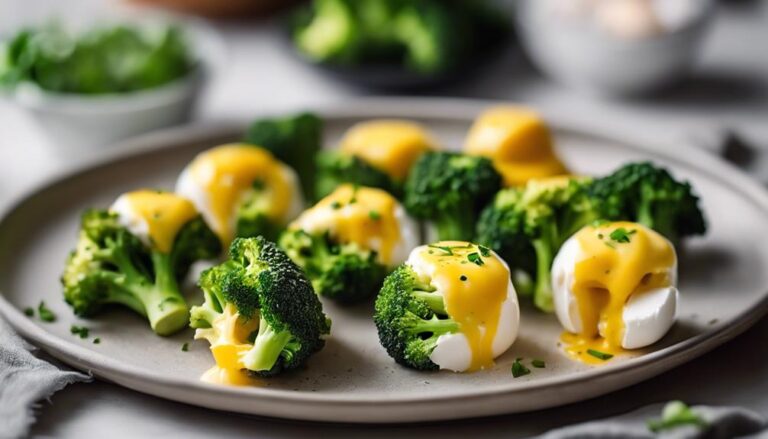Fill-Up With Sous Vide Root Vegetables and Quinoa Pilaf
Immerse yourself in the rich flavors of sous vide root vegetables and quinoa pilaf. Elevate your meal with nutrient-packed goodness and enhanced taste. With sous vide cooking, you preserve the unique textures and flavors of the root veggies to perfection. Add a touch of herbs and spices to your quinoa for an explosion of taste. Experiment with different seasonings and glazes for that extra flavor boost. Create a balanced and scrumptious dish that will impress your guests or satisfy your own palate. Give in to the culinary delight that awaits.
What You Will Learn Here
- Sous vide cooking preserves nutrients and enhances flavors of root vegetables and quinoa pilaf.
- Infuse quinoa pilaf with herbs and spices for added taste and nutrition.
- Experiment with different glazes and seasonings for flavor enhancement.
- Vacuum-seal ingredients for rich flavors and perfect cooking.
- Apricot marmalade and brown sugar glaze add a delightful touch to the meal.
Root Vegetable Origins
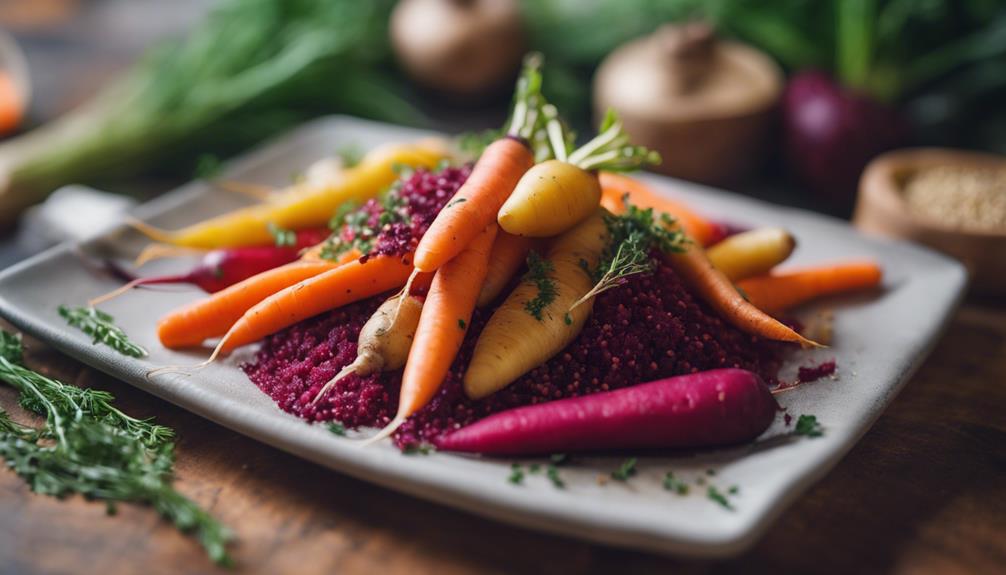
Root vegetables, a category encompassing plants with edible parts growing underground, have a rich history in the culinary world. They bring a delightful mix of flavors, textures, and nutrients to dishes.
From the earthy sweetness of carrots to the creamy richness of parsnips, root vegetables offer a diverse range of options for cooking and eating.
Root Vegetable Types
Have you ever wondered about the origins of these humble yet nutritious plant roots that grace our plates in various delicious forms? Root vegetables, such as carrots, parsnips, turnips, radishes, and sweet potatoes, have a long history of cultivation dating back centuries.
These vegetables not only add depth and flavor to dishes but also provide essential nutrients like fiber, vitamins, and minerals. Each type of root vegetable brings its unique taste and texture to the table, making them versatile ingredients in cooking.
Their natural sweetness can enhance the overall flavor profile of a dish, whether they're roasted, steamed, boiled, or incorporated into soups and stews. So, next time you cook with root vegetables, remember the rich history and nutritional value they bring to your meals.
Nutritional Benefits
Exploring the nutritional advantages of root vegetables exposes a wealth of vitamins, fiber, and antioxidants that not only feed your body but also add to a lively culinary experience. Root vegetables, such as carrots and parsnips, are low in calories but high in essential nutrients, making them a smart choice for a healthy diet.
These veggies pack a punch with vitamins A, C, and K, along with a good dose of fiber to keep you feeling full and satisfied. Their antioxidant content helps protect your cells from damage and supports overall well-being.
Culinary Uses
With a history deeply rooted in various culinary traditions, the origins of these versatile root vegetables date back centuries to different regions across the globe. Root vegetables like carrots, parsnips, beets, turnips, and sweet potatoes have been essential ingredients in diverse cuisines worldwide. Their earthy flavors and nutrient-rich profiles make them popular choices for creating hearty and flavorful dishes.
When cooked using sous vide techniques, these vegetables retain their natural textures and flavors, allowing for precise cooking results. Sous vide cooking, with its controlled water bath method, enhances the taste and nutritional benefits of root vegetables, making them a delightful addition to dishes like quinoa pilaf.
Root Vegetables in Sous Vide
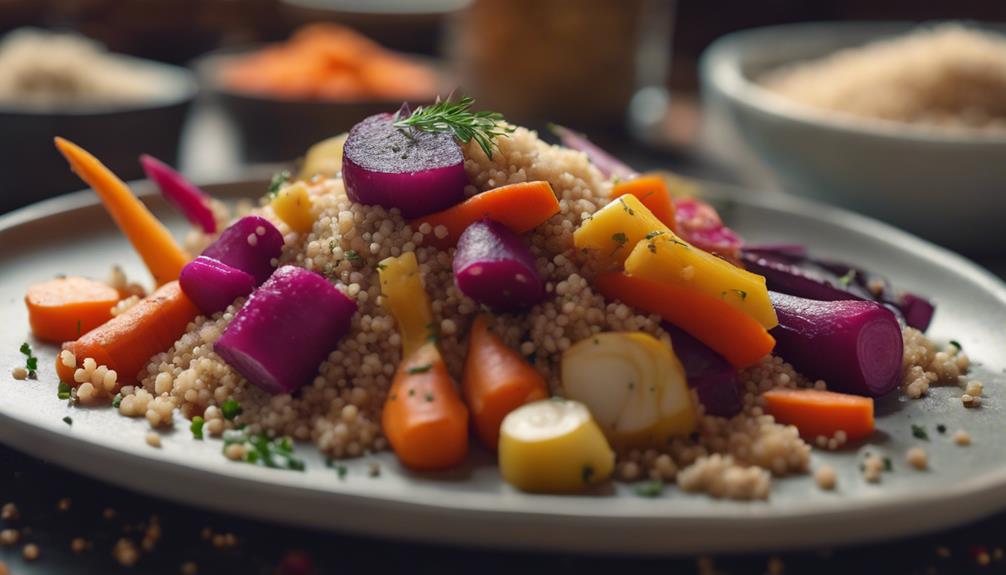
Root vegetables excel in sous vide cooking, where their natural flavors and nutrients are precisely maintained through accurate temperature control. When cooked sous vide, root vegetables like carrots and parsnips undergo a transformation that enhances their taste and texture. Here's why sous vide root vegetables are a must-try:
- Intensified Flavor: Sous vide cooking seals in the inherent flavors of root vegetables, resulting in a more concentrated and lively taste profile.
- Enhanced Nutrition: By cooking at precise temperatures for extended periods, sous vide preserves the nutrients that might be lost through traditional cooking methods.
- Uniform Texture: The consistent heat distribution in sous vide guarantees that root vegetables are evenly cooked, providing a uniform and satisfying texture.
- Minimal Nutrient Loss: Unlike boiling or steaming, sous vide minimizes the loss of essential vitamins and minerals, making your root vegetables not just delicious but also nutritious.
Sous vide root vegetables offer a delightful combination of flavor, texture, and nutrition to your plate, making them a versatile and healthy side dish option.
Tasty Sous Vide Creations
You've mastered the art of Sous Vide cooking with root vegetables and quinoa pilaf, but have you tried experimenting with other tasty creations?
Imagine the delightful combination of quinoa and roasted root vegetables or the savory goodness of quinoa-stuffed bell peppers and acorn squash.
These Sous Vide dishes offer a burst of flavors and textures that will elevate your culinary skills to new heights. Try these innovative recipes and prepare to be amazed by the delectable results.
Quinoa and Roasted Root Vegetables
For a delicious and nutrient-packed meal, explore the delightful combination of quinoa and perfectly sous vide-roasted root vegetables.
The roasted root vegetables like carrots and parsnips offer a satisfying crunch and a burst of earthy flavors. Pairing them with quinoa, a complete protein and fiber-rich grain, creates a well-rounded dish that will leave you feeling nourished.
The sous vide cooking method guarantees that the vegetables are tender and bursting with flavor, enhancing the overall texture of the dish. Drizzling apricot marmalade over the vegetables adds a sweet and tangy glaze, elevating the taste profile to a whole new level.
This dish strikes a perfect balance between savory, sweet, and earthy notes, making it a delicious and wholesome meal option.
Quinoa-Stuffed Bell Peppers
When preparing Quinoa-Stuffed Bell Peppers using the sous vide method, the flavors meld together perfectly, creating a dish that's both satisfying and nutritious. The peppers become tender, while the quinoa pilaf inside absorbs all the savory juices, resulting in a delightful meal. Here's why you should try making Quinoa-Stuffed Bell Peppers:
- The bell peppers' vibrant colors contrast beautifully with the quinoa pilaf, making for an eye-catching dish.
- Each bite offers a mix of textures, with the softness of the pepper complementing the slightly chewy quinoa.
- The filling possibilities are endless; you can add ingredients like roasted root vegetables for extra depth of flavor.
- Sous vide cooking guarantees that every component is cooked to perfection, ensuring a consistent and delicious outcome every time.
Quinoa-Stuffed Acorn Squash
Enhancing the nutty essence of acorn squash, this sous vide rendition of Quinoa-Stuffed Acorn Squash delivers a delectable fusion of flavors and textures in every bite. When you prepare this dish, imagine the following:
- The tender acorn squash, roasted to perfection, offers a subtle sweetness that pairs harmoniously with the savory quinoa stuffing.
- As you take a bite, the fluffy quinoa mixed with a medley of roasted vegetables creates a satisfying combination of textures.
- The aroma of the spices and herbs infused in the quinoa fills the air, tantalizing your taste buds before even tasting the dish.
- The vibrant colors of the stuffed acorn squash on your plate make for an inviting and visually appealing presentation, perfect for a wholesome meal.
Enhancing Quinoa Pilaf Flavor
Enhancing the flavor of your quinoa pilaf is a culinary adventure waiting to happen. By using vegetable stock instead of water, you infuse a deeper taste into each grain.
Marinating tofu croutons adds a luxurious richness, while a sprinkle of Parmesan cheese on top can take your dish to the next level.
Flavorful Ingredient Combinations
Combining root vegetables like carrots and parsnips with quinoa creates a rich, earthy flavor profile that elevates the pilaf to a new level of culinary delight. The natural sweetness of carrots and the slightly peppery undertones of parsnips bring essential values to this dish. These veggies not only provide a hearty base but also infuse the quinoa with a depth that complements various flavors.
The addition of apricot marmalade and dark brown sugar layers on a delightful sweetness, while dry mustard and unsalted butter contribute complexity. Considering experimenting with ingredients like orange or ginger preserves can offer unique twists to the sous vide root vegetable and quinoa pilaf, allowing for a versatile and exciting culinary experience.
Seasoning for Added Taste
For an intriguing twist to your quinoa pilaf, consider infusing it with a blend of aromatic herbs and spices. Enhance the flavor profile by adding a pinch of salt and pepper to season the quinoa perfectly.
Drizzle a hint of olive oil to bring out the richness of the ingredients and create a delightful mouthfeel. The combination of thyme, rosemary, or parsley can elevate the earthy tones of the dish, while spices like cumin, turmeric, or smoked paprika add a depth of flavor.
Experiment with garlic, ginger, or shallots for a savory kick that will tantalize your taste buds. Incorporating these seasoning options will result in a quinoa pilaf bursting with delicious and well-balanced flavors.
Cooking Techniques for Enhancement
To elevate the flavor of your quinoa pilaf, consider employing various cooking techniques that enhance the overall taste profile of the dish. Sous vide cooking is a fantastic method to infuse the quinoa pilaf with rich flavors. By vacuum-sealing the ingredients with a flavorful glaze, the quinoa and root vegetables can guarantee all the delicious tastes without losing any during cooking.
This technique guarantees that every bite is bursting with the essence of the glaze, adding depth and complexity to the dish. Experimenting with different glazes and seasonings can further customize the flavor to suit your preferences, creating a unique and satisfying meal that's sure to impress your guests. Sous vide cooking offers precision and excellence in flavor enhancement for your quinoa pilaf.
Final Thoughts
What makes this sous vide root vegetables and quinoa pilaf recipe truly stand out is its perfect melding of flavors and textures, creating a wholesome and satisfying meal. The precise temperature control of sous vide cooking guarantees that the root vegetables are cooked to perfection, retaining their natural flavors and nutrients.
This cooking technique is ideal for those looking to maintain a healthy lifestyle as it helps safeguard the vegetables' nutritional value. The quinoa pilaf serves as a nutritious base, offering a balanced combination of protein, fiber, and essential vitamins and minerals, making it a great choice for individuals following a calorie-conscious diet.
The sweet glaze made with apricot marmalade and brown sugar adds a delightful touch to the dish, elevating its taste profile. To achieve the best results, remember to cook the vegetables at medium heat to ensure they're tender yet still retain a slight crunch, enhancing the overall dining experience.
Enjoy this flavorful and nourishing sous vide root vegetables and quinoa pilaf as a hearty meal that will leave you feeling satisfied and energized.
Frequently Asked Questions
Can Root Vegetables Be Cooked Using Other Methods Besides Sous Vide?
You can cook root vegetables through various methods besides sous vide. Roasting brings out their natural sweetness, while steaming retains nutrients. Boiling may lead to nutrient loss, but grilling adds a smoky flavor. Experiment with different techniques to find your favorite.
Are There Any Specific Root Vegetables That Should Be Avoided When Using the Sous Vide Method?
When using sous vide, it's important to take safety into account. Some root vegetables like cassava have toxins that necessitate high heat for neutralization. Opt for veggies like carrots, beets, and parsnips for a delicious and safe flavor profile.
How Can I Incorporate Sous Vide Root Vegetables Into Different Dishes Besides Quinoa Pilaf?
To incorporate sous vide root vegetables into various dishes beyond quinoa pilaf, consider roasting or sautéing them to enhance flavors and textures. Get creative with pairings like adding them to salads, tacos, soups, or even as a side dish for protein.
Are There Any Tips for Storing Leftover Sous Vide Root Vegetables?
For storing leftover sous vide root vegetables, opt for airtight containers to preserve freshness. Keep them refrigerated at a proper temperature below 40°F. This guarantees your veggies stay safe to eat and maintain their delicious flavors for longer.
Can Quinoa Pilaf Be Made Ahead of Time and Reheated Later?
When prepping meals, making quinoa pilaf ahead is a smart move. Reheating techniques like microwave or stovetop can maintain its flavors. Convenience meets flavor in this meal prep gem. Enjoy the ease!
Conclusion
Indulge in the earthy flavors of sous vide root vegetables and quinoa pilaf, a harmonious blend of textures and tastes that will leave you feeling satisfied and nourished.
The sous vide technique reveals the full potential of these humble ingredients, infusing them with rich flavors and preserving their nutrients.
Elevate your next meal with this delicious and wholesome dish that showcases the beauty of simple, yet sophisticated cooking methods. Bon appétit!
